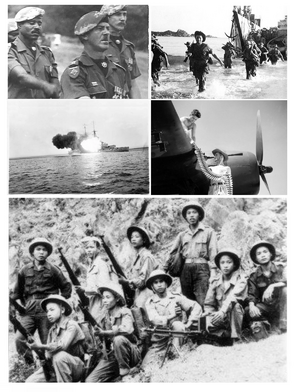Kenlongese War
This article is incomplete because it is pending further input from participants, or it is a work-in-progress by one author. Please comment on this article's talk page to share your input, comments and questions. Note: To contribute to this article, you may need to seek help from the author(s) of this page. |
| Kenlongese War | ||||||||||
|---|---|---|---|---|---|---|---|---|---|---|
| Part of the Great Game | ||||||||||
 Clockwise, from top left:
| ||||||||||
| ||||||||||
| Belligerents | ||||||||||
|
Supported by: |
Supported by: |
Note: The various communist factions often participated in hostile actions between each-other. | ||||||||
| Commanders and leaders | ||||||||||
|
|
|
| ||||||||
| Strength | ||||||||||
|
State of Kenlong Regulars: 185,000 Town militia: 68,000 Police and other law enforcement: 16,000 Republic of Melasia Melasian marine corps: 25,000 Melasian Home Guard: 46,000 Total: c. 340,000 |
Kingdom of Kenlong Regulars: 250,000 (1948) Irregulars: c. 268,000 Mascyllary Empire Colonial troops: c. 7,200 Total: c. 525,200 |
People's Liberation Front Irregulars: 45,000 (peak) Mèo Insurgency Irregulars: c. 17,200 Total: c. 62,200 | ||||||||
| Casualties and losses | ||||||||||
|
|
25,000 imprisoned in Melasian labour camps |
14,000-29,000 captured by both sides | ||||||||
| ||||||||||
The Kenlogese War (generally referred to as the Kenlongese Revolution in Melasia and the War of Independence in Kenlong, sometimes mentioned as the Kenlongese Civil War) was an armed conflict that started in the State of Kenlong shortly after the end of the Melasian Crisis and lasted until March 3, 1951. Hostilities in the region began during the crisis itself, with Mascylla aiding the local independence movements in an attempt to weaken the Melasian military and establish an independent state of Kenlong. The main hostilities in the conflict were between the State of Kenlong, a puppet regime established by Melasia as a result of the Melasian Crisis, backed up by Melasia itself, and supporters of the former King of Kenlong, who was dethroned as a result of the Kenlongese defeat in the Great War. In addition, numerous communist and radical religious guerrillas emerged in the country during the conflict, fighting both sides and often each other.
Following the defeat of the Kingdom of Kenlong in the Great War, it was made a AN mandate of the Federated Melasian States, then itself a dominion of the Mascyllary Empire. Following the independence of Melasia and its transformation into a unitary republic, the Assembly of Nations abolished its mandate over the Kenlongese territory, but the Melasian state refused to grant its mandate independence and continued its control over it. Following the Melasian Crisis, Melasia was finally forced to grant independence to Kenlong, which it formally did by installing loyal politicians and forming the State of Kenlong, an one-party dictatorship which remained largely a puppet state of Melasia. Melasia also preserved strong military presence in the country, operating most military airfields in the country as its bases. In the meantime, a neo-royalist movement under Prince Hồ Hoàng Thái formed in the western part of the country, heavily supplied by Mascylla. As numerous members of the Assembly of Nations, namely Lavaria and Falland among others, began to notice the growing support for the loyalists among the Kenlongese population and the complete lack of effort from the Melasians to assure the independence of the Kenlongese state, they decided to recognize the royalist movement of Prince Hồ Hoàng Thái as the sole legitimate power in Kenlong. With the support of most of the Berean states, the royalists started a conventional war against the State of Kenlong shortly after its official establishment in September 1944. After several months of active warfare and the liberation of almost one-third of the Kenlongese territory, Melasia declared war on the royalist movement, officially entering the conflict. Both sides received modern military equipment and support from Berean states. Melasian forces performed numerous bombings of Kenlongese cities under royalist control but eventually failed to stop the advance of Prince Hồ's troops. By mid-1946 most of State of Kenlong and Melasian Cunochuye were under royalist control, with only the capital city and the sothern part of the Manatan Peninsula remaining under joint Melasian and collaborationist control. Parallel to the conventional warfare between royalist and collaborationist forces, large-scale guerrilla warfare occured throughout the conflict between both sides and numerous religious and far-left movements, including the People's Liberation Front of Kenlong and the Mèo Insurgency, both backed up by communist states like the People's Republic of Dulebia.
Several attempts for Melasian naval and airborne landings in Gi Lang and Liep Te ended in a bloody failure, marking the highest loss of Melasian lives since the Great War. Another landing operation in the bay of Song Lon, nicknamed Operation White Moon, initially succeeded in driving royalist troops back, but eventually all ground gained had to be left due to shortage of resources. The frontline remained relatively still for almost two years between early 1949 and late 1950. The so-called Winter Offensive of December 1950 eventually managed to break through the Melasian defences at Phuong Hoang and resulted in the capture of the capital city, eventually leading to the withdrawal of all Melasian forces in Kenlong.
Following its defeat at Phuong Hoang, Melasia and the Kenlongese royalists signed the Treaty of Tinz am Sigmund, in which Melasia recognized Prince Hồ Hoàng Thái as the sole legitimate ruler of Kenlong, and ceded Melasian Cunochuye and the Northern Caroline Islands to Kenlong. The signing of the Treaty of Tinz am Sigmund marked the formal end of the Kenlongese War, with numerous smaller engangements inside the country between the newly-established government of now King Hồ Hoàng Thái and various radical movements continuing into the next decade. The Kenlongese War was the bloodiest conflict after the Great War, and marked the start of a small cold war between the Republic of Melasia and the Kingdom of Kenlong for dominance in the region.


